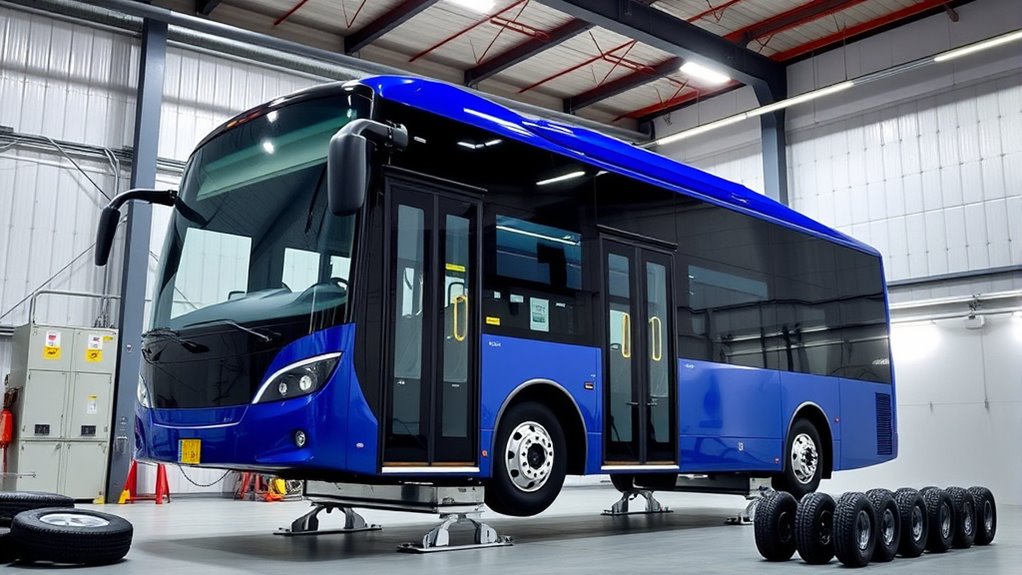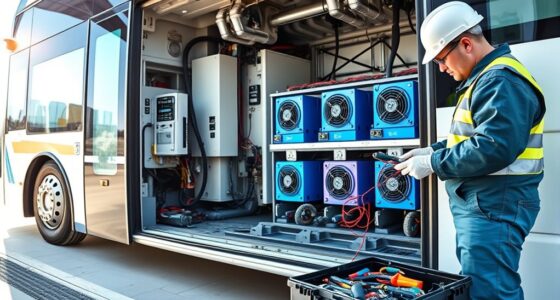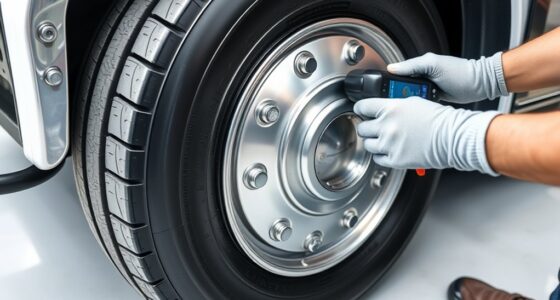To store your electric buses effectively during off-seasons, keep them in climate-controlled indoor spaces between 40-86°F, and guarantee they are charged to 50-80% to prevent battery damage. Regularly inspect batteries, tires, and systems, and keep buses clean to avoid corrosion. Use solar energy for mid-day charging and precondition batteries before use. Pay attention to cold-weather strategies like insulation and driver training, and explore more tips to maximize longevity.
Key Takeaways
- Store buses indoors in climate-controlled environments maintaining 40-86°F to protect battery health and mechanical integrity.
- Keep batteries charged at 50-80% and perform regular inspections to prevent deep discharge and detect issues early.
- Schedule mid-day or end-of-day charges using solar energy to maintain optimal battery temperature and efficiency.
- Conduct routine cleaning, inspections, and preconditioning, especially in cold climates, to preserve systems and readiness.
- Use insulation, natural sunlight, and minimal door openings to conserve heat and reduce cold-weather-related battery and cabin issues.

Storing electric buses properly during off-seasons is essential to guarantee their longevity, performance, and safety. When you store your buses, the environment plays a crucial role. Ideally, keep them in a climate-controlled space where temperatures stay between 40 and 86 degrees Fahrenheit. This helps prevent battery degradation and mechanical issues caused by extreme temperatures.
Proper off-season storage maintains electric bus performance and safety by controlling temperature and environment conditions.
If indoor storage isn’t an option, use shaded areas or outdoor canopies to shield the buses from direct sunlight and harsh weather conditions. Sun exposure can lead to overheating and accelerated wear, so minimizing this exposure helps maintain the bus’s condition. If you need to store buses outside, good shading can make a significant difference in preserving their components and overall health.
Proper maintenance during storage is equally vital. Regularly check the batteries to ensure they stay healthy, and avoid leaving them fully discharged. Store the buses with a moderate charge level—around 50-80%—to prevent deep discharging, which can damage the battery. Before you plan to use the buses again, precondition them by warming up the batteries and the cabin, especially in cold climates. This step improves performance and reduces energy consumption when they’re back in service.
Inspection routines should include checks of brakes, tires, and electrical systems to catch potential issues early. Also, keep the buses clean, as dirt and debris can cause corrosion and impair systems over time. Additionally, maintaining proper battery health during storage is crucial for sustaining their capacity and longevity. Regular cleaning and inspection can further prevent corrosion and ensure systems remain in optimal condition.
Charging strategies during storage can optimize battery life and readiness. Mid-day charging, which utilizes solar energy, can help keep batteries warm and topped up without overtaxing the system. Charging at the end of the day ensures the batteries are already warmed up, improving charging efficiency. To reduce costs and demand on the grid, avoid charging during peak hours and consider scheduled charging times. If possible, use grid power for preconditioning to lessen battery strain and improve energy efficiency.
Proper training for drivers and maintenance staff is critical. Educate drivers on cold-weather operations and efficient route planning to mitigate range limitations during winter. Familiarize them with emergency procedures, especially for battery issues, and develop cold-weather strategies such as insulation enhancements and door management to reduce heat loss.
Using additional insulation and limiting door openings help maintain cabin temperature, while efficient heating systems, like preconditioning, conserve energy. Natural sunlight can be harnessed through solar heating, reducing the need for additional warmth. Additionally, implementing advanced battery management systems can monitor and optimize battery health during storage, further extending their lifespan. Staying informed about battery degradation mechanisms can help develop better storage protocols and improve longevity.
Tailoring storage and operational practices to your local climate ensures your electric buses remain reliable, safe, and ready for service when the season changes.
Frequently Asked Questions
How Often Should Electric Bus Batteries Be Charged During Storage?
You wonder how often you should charge your electric bus batteries during storage. To keep them healthy, charge them periodically to maintain around 50% charge—typically every 4 to 6 weeks, depending on storage conditions.
Avoid overcharging or letting them fully discharge. Regular checks help identify any issues early, ensuring the batteries stay in good condition and ready for use when needed.
What Environmental Conditions Best Preserve Electric Buses Off-Season?
To preserve your electric buses off-season, you should keep them in a climate-controlled environment, ideally indoors at 55–60°F, to prevent battery degradation.
Avoid sub-freezing outdoor storage and choose sun-exposed parking areas to passively warm batteries.
Precondition battery temperature before storage, monitor temperature thresholds, and guarantee proper ventilation.
These conditions help maintain battery health, reduce energy drain, and ensure the buses are ready for use when needed.
Are Special Maintenance Checks Needed Before Long-Term Storage?
Before long-term storage, you should perform special maintenance checks on your electric bus. Start by inspecting the battery’s state of charge, ensuring it’s between 50-70%.
Disconnect the 12V accessory battery if stored over a month. Check fluid levels, inflate tires properly, and clean the vehicle thoroughly.
Also, verify that thermal management systems work, and make certain the storage environment remains dry and temperature-controlled to prevent deterioration.
Can Electric Buses Be Stored Outdoors or Should They Be Kept Indoors?
You can store electric buses outdoors, but it’s better to keep them indoors if possible. Indoor storage provides a controlled environment that protects batteries and electrical systems from extreme temperatures, reducing maintenance and improving efficiency.
Outdoors, you should use shaded areas, canopies, or covers, and ensure regular maintenance.
Proper indoor storage minimizes temperature fluctuations, prolongs bus lifespan, and saves energy, making it the preferred option for long-term off-season storage.
How Do Storage Practices Differ Between Lithium-Ion and Other Battery Types?
You should know that storage practices differ markedly between lithium-ion and other battery types. Lithium-ion batteries require indoor, climate-controlled environments at 40–86°F, with partial charges around 30–50%. They benefit from active thermal management, minimal ventilation, and insulation.
In contrast, older batteries like lead-acid need full charges, proper ventilation, and less temperature regulation. Lithium-ion’s lighter weight and modular design make storage easier, but you must monitor SOC closely to prevent damage.
Conclusion
Remember, a stitch in time saves nine. Properly storing your electric buses during off-seasons guarantees they stay in top shape and ready when needed. Follow best practices like keeping batteries charged, protecting from the elements, and conducting regular inspections. By staying proactive, you’ll extend your buses’ lifespan and avoid costly repairs. Don’t wait until problems arise—invest in good storage today, because a well-maintained vehicle is an investment in your future success.









